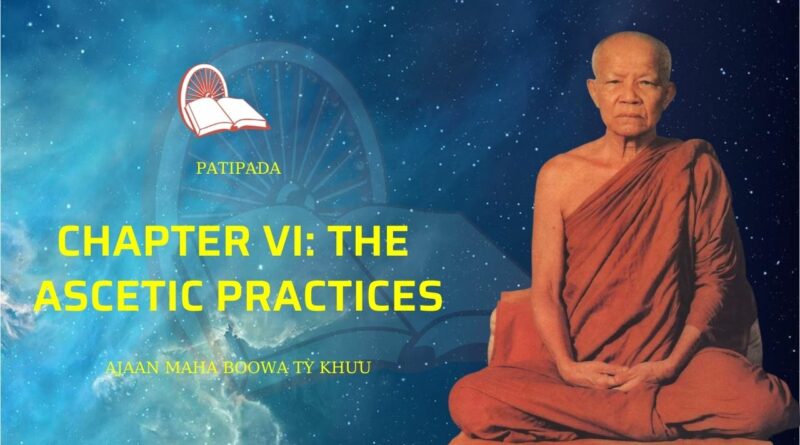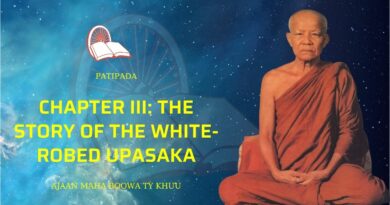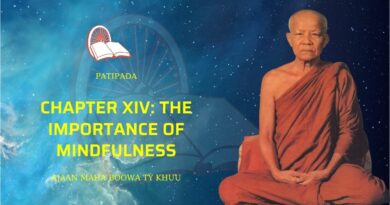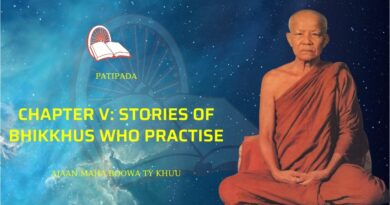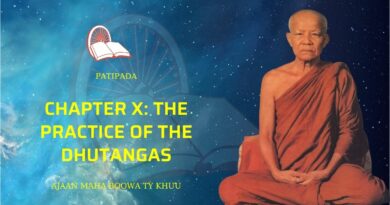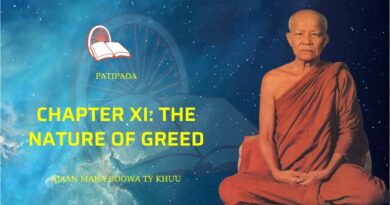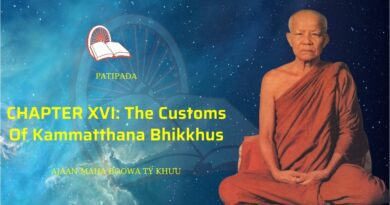PATIPADA – CHAPTER VI: THE ASCETIC PRACTICES
Each one of the thirteen Dhutanga practices are capable of subjugating the kilesas of all kinds, and this they are able to do in the most wonderful manner which is almost impossible to anticipate. But they have already been elucidated in “The Biography of Venerable Acharn Mun”, sufficiently well, so we will not give any lengthy explanation of them here, although it must be kept in mind that all the Dhutanga Bhikkhus who are followers of Venerable Acharn Mun, in their various ways continue to maintain those practices which were in line with his tradition.
Those of the thirteen Dhutangas which have been elucidated in “The Biography of Venerable Acharn Mun” are as follows (unless the writer’s memory is at fault):
- Dwelling under the shade of a tree.
- Going pindapata as a regular duty.
- Eating from the bowl.
- Eating only once a day.
- Using only pamsukula robes
- Not accepting any food given after the pindapata round.
Any further explanation of these will only be minor additions to those that have already been given.
Having written the above, I went and talked about it with some of my colleagues, saying that I was not going to repeat my explanation of the Dhutangas because it was already in “The Biography”. But most of them thought that the explanation of the Dhutangas should be repeated here because one cannot be sure that all who read this will also have read “The Biography”. Some may never have seen it and thus they may not have a chance to know how important the Dhutanga observances are in the practice of Dhamma. So finally I decided that it was necessary to include some explanation of them. But I ask for the indulgence of those who have already read about the Dhutangas in “The Biography of Venerable Acharn Mun”, that they do not become irritated by the repetition, and understand that this has been included to help those who have never learnt anything about the thirteen Dhutanga observances.
The Dhutanga observance of dwelling under the shade of a tree (rukkhamula) was the first of the Dhutangas to be practised by the Lord Buddha. On the day when he penetrated Dhamma (Enlightenment) and the three worlds shook, he was sitting under the shade of a tree — the great Bodhi tree which Buddhists have looked upon as a sacred tree and synonymous with Buddhism (Sasana) and the Great Teacher (Sasada), right up to the present day. Also, when the Lord entered Parinibbana, it occurred under the shade of trees — the twin Sala trees. This is what is meant by “rukkhamula” in this Dhutanga observance.
Living in a hut, roofed and closed about gives security against various dangers, which is very different from living under the shade of a tree. This can be learnt from those who have stayed both indoors in a hut or vihara and also “rukkhamula”, under the shade of a tree where it is lonely. The heart feels how the first is warm and cosy while the second is very lonely, and how different they are. This is even more so when either the hut or the tree shade are in a lonely, desolate forest full of wild animals including tigers. One who does this will see quite clearly that there is a remarkable difference between the hut and the shade of a tree. Living in a hut in desolate forest can be enjoyable, for one can sit relaxed and lie down rather than finding enjoyment in the meditation practice — which deteriorates. For, doing it in this way is comfortable and free from all sorts of fears and uncertainties.
As for someone who stays under the shade of a tree in desolate forest, without any protection, so that he has nowhere to escape to where he could sit or lie down in comfort and relaxed, he must be on guard against ever present dangers whatever he does. His mindfulness and his citta have no time when they can part from each other, for fear that he may be caught at a disadvantage whenever danger approaches, which may come at any time, whatever he is doing.
In these two ways of staying in the forest, the differences as regards the pleasurableness of the one and the uneasiness of the other, is very great. One who stays under the shade of a tree will suffer a lot in almost every way. But as far as his samadhi bhavana goes, if he is someone who is intent on Dhamma, he will develop and gain more by the practice of “rukkhamula”. Because in all postures and movements he will act in the manner of one who is striving, excepting only when he sleeps.
The force of the fear of danger drives him to be watchful and careful and to maintain mindfulness, which he dare not allow to depart from the heart. This is undoubtedly of great value in helping him to make that effort which can cause the citta to develop in samadhi and wisdom. Therefore, for a “warrior” who is ready to face death, the Dhutanga of living under the shade of a tree in a desolate forest is like going into the front line of battle. Even though his citta has never attained calm, never known what samadhi and pañña are like, nor what the experience of the Path, Fruition and Nibbana means, when he sets up mindfulness inwardly, in intimate contact with the heart, making an effort to guard it and prevent it slipping away, then his meditation practice will be correct, and complete with mindfulness, and regardless of which aspect of Dhamma he is using as his preparatory meditation technique (parikamma–bhavana) his meditation practice will be correct and complete with mindfulness. Likewise, when examining and questioning the true state of nature (sabhava–dhamma) to see it clearly with wisdom, then true wisdom can arise when mindfulness is there to control the mind. Mindfulness is therefore an essential component of mind (dhamma) and is of the greatest importance in affairs, both internally and out in the world.
Those who live in desolate, lonely places, under the shade of a tree, or in similar ways, for the purpose of self-training, therefore have a much better opportunity to promote their striving in this way than have those who stay where they feel safe and secure and where they feel no anxiety at all, such as in a hut. The value of staying under the shade of a tree is to be found in the way it prevents one from relaxing into complacency and self-satisfaction. Thus it makes one mindful of oneself, which leads to the development of samadhi samapatti (ability in samadhi) and Magga–Phala–Nibbana (the Path, Fruition and Nibbana) in a steadily progressive manner with no wasting of time or delay, nor any doubts or hesitation due to negligence and complacency. Those who have been living “rukkhamula” in desolate forests until they have become used to it are like experienced fighters in a war who have no fear of the enemy, for they can live anywhere, which is very different from those who have had little training.
Venerable Acharn Mun used to praise the practice of staying under the shade of a tree, in a manner that left a deep impression on those who heard him and it was a topic that he often brought to mind and talked about, right up to the end of his life. He used to speak about it in such a manner as to bring all his followers to their senses and make them think about their own situation and to arouse interest in the practice of living the way of “rukkhamula”. He used to say that:
“If my Bhikkhus want to know about themselves, both in regard to what is gross and subtle, and to have confidence in their own abilities, such that they know whether or not they are Bhikkhus who practise the way in full measure, they ought to go and take up the practice of “rukkhamula”, living under the shade of a tree in a desolate forest which is full of tigers and other wild animals to keep them alert. In addition, this will test and show to what extent they are skilled and fearless and also the extent to which they are incompetent and timid, until they know fully, in all ways, what is meant by ‘living rukkhamula’, which was established by the Lord Buddha.”
“Once one knows the fears that are inherently in one’s nature, and the courage that comes from the effort one makes, which can clean them out, then Sila, Samadhi, Pañña and the higher Dhamma will increase stage by stage. They are most likely to develop in association with each other and one will know their progress in one’s heart as it occurs, step by step. This is the way in which one can see the value of this Dhutanga practice to one’s heart’s contentment.”
“The Lord Buddha and his Savakas all upheld the practice of this Dhutanga as an inherent part of their life of striving, from beginning to end, which was never given up. Because it is the dwelling place of those people who are alert and zealous — not heedless and complacent — and the striving which they did by way of the citta brought gains and development until they reached the end of the road, and nothing in the whole universe can compare with this. So the Lord established his teaching of “rukkhamula”, to act as a signpost, pointing the way. It was as if he was saying:
“This is the way to go if you want to overcome all fear, and danger and get free from dukkha. You are all so dim, dull and sluggish and what are you going to do about it? This place, is not a dull place, unsuited to mindfulness and wisdom, but a place that arouses and revives mindfulness, wisdom and striving in all ways, so that they become mature, strong and penetrating. Come now! We, the Tathagata, will lead the way without hesitation. Don’t go on messing about in a disorderly way, shouldering your heavy burden by thinking that you have sufficient strength and ability to continue on your own. For when you come to a critical situation with no escape you will have nothing in you to turn to. You must be quick now and search for a suitable battle field where you can gain victory, such as under the shade of a tree. There the citta will reach that Dhamma which is proper to the heart and void of all kilesas and Dukkha of all kinds. It was in such a place as this that the Tathagata was able to gain ascendancy over all the kilesas so that they gave in completely. Over there is the Sri–Maha–Bodhi Tree which is the symbol of the great victory of the Tathagata, and if this is not “rukkhamula”, what else can you call it? Prince Siddhattha was enlightened and became the Lord Buddha at the foot of the Sri–Maha–Bodhi Tree. But if you are still in doubt, where else will you go and search for Dhamma if not in the same kind of place as the Tathagata used to search for and know it. A place such as this is sacred to those who see danger.
“For where else should you go groping in delusion to search for sacred places? That which is sacred within yourselves is the most longed for holy refuge, more desirable than anything else. You must search for it until you find it, and the place to search for it is in your own hearts, while depending on and aided by a suitable place to act as the field where you dig down searching in this way.”
Whatever aspect of Dhamma was revealed by Venerable Acharn Mun, such as the foregoing example, made a deep impression, touching the hearts of those who heard it. For it was teaching that came from the true knowledge and understanding of one who was true in himself. There was no room to doubt it nor think that the way of practice to attain the Path, Fruit and Nibbana should be anywhere else except in the practice of someone who does it entirely with “Samici–kamma” (actions that are appropriate and right). This was even more so when one listened directly to Venerable Acharn’s teaching, for it was as if he drew the Path, Fruit, and Nibbana out of his heart, so that his followers who were blind (mentally) could feel it, enough to make them long for it with regret before returning it to its original place. In other words, when Venerable Acharn Mun gave a Dhamma talk it seemed almost as though he brought it out from within him for others to see.
Then as soon as he finished it was as if he put it back where it came from — in his own heart. Listening to him made us feel as if we were flying high and walking on the clouds. But once he finished we became like a lot of blind men groping for the way and unable to find it. Uncertain about this, uncertain about that; thinking that this is good and that is best. Picking up both the rice husk and the kernel. Picking up all sorts of unessential things, as well as the main essentials, which does not lead to anything valuable. They could just as well accept their fate and leave it at that. Living at the Foot of a Tree (rukkhamula).
Venerable Acharn Mun said, this had brought him remarkable results all the time, so he liked staying in such places and never got tired of it. When staying in a place without a roof and walls, or anything else, to protect one from danger, the citta is bound to be afraid and insecure. This is especially so at night, and for a timid person, whatever he sees he will believe is a tiger. So in the case of one who is very timid, he should in the daytime take note of where all the bushes are located round about where he is staying so that at night he can see them and know what they are. Otherwise the bushes in the locality where he is staying will become tigers in his imagination and they will deceive him all night so that he will hardly be able to lie down and sleep or do any meditation practice.
One who lives the way of “rukkhamula” is much more careful and cautious than someone who lives in a place that is closed about, both as regards physical movements involved in his living routine and in lying down and sleeping, and also in his samadhi meditation practice. Consequently his citta is likely to go forward and progress more rapidly, despite the fact that no compulsion has been used and nobody has forced him to do this. On the contrary, it is freely undertaken by each Bhikkhu who decides to look for a way to train and discipline himself.
Sometimes, while a Bhikkhu is sitting practising samadhi under his mosquito net and beneath the shade of a tree (rukkhamula), a tiger creeps up very slowly to have a look at him and sniff him out. Some may even come right in close to where he is staying, but once it knows that it is a human being it quickly draws back and goes away and never comes back again. It probably creeps up close in this way to have a look because it does not know what is there, never having seen anything like this before. But there are some tigers which seem to have unusual hidden characteristics which makes them suspicious. This was shown by the experience of a Bhikkhu who was walking cankama at night without having lit a lamp. For a tiger crept up quietly until it came to within two yards of the end of the path where he was walking, where it crouched down and watched him without going away. Then this Bhikkhu heard a slight sound which he could not account for so he shone a flashlight towards it and saw this tiger which immediately leap away, but he never saw it come back again after that. In this case the animal was a large striped tiger about the size of a race horse. It was not a leopard which likes to creep up and catch and eat dogs which often like to accompany people who go into the forests.
The Dhutanga Bhikkhus who live in the manner of “rukkhamula”, go through various experiences which are fearful and frightening, of which a small number have been told here. If you can imagine yourself in the position of one of these Bhikkhus, living in the manner of “rukkhamula” and experiencing these various things which happen, how would you, who are reading this, feel about it. If you could put up with it and take the discipline until it became your story, a fine and beautiful biography, it would be truly worth something — a story for future generations to hold up as an example, as a guiding principle in the heart. But for one who cannot put up with the difficulties nor accept the ascetic training, there is reason to fear that his biography will be of the type that brings discredit to himself, to his colleagues and to the religion which is the heart of all Buddhists, staining it in a way that nothing can erase for a long time. He also becomes a person who has feelings of inferiority, so the sphere of kammatthana and the religion become inferior. Because they depend on oneself, who is an incompetent person, who drags all these things of incomparable value to ruin with him.
Merely using one’s imagination to try it out for a moment is enough to make one realise how difficult for the body and tormenting to the mind is the way of those who strive and struggle using such methods, right from the start of the life of Dhutanga–Kammatthana, until they are able to plant their roots firmly in all the forms of Dhamma, due to their determination to go this way however difficult it may be. Wherever people live, it is hard to find anyone who has enough strength of will to go this way and to make sacrifices such as this. For most people are afraid of suffering and think only of themselves rather than of Dhamma which is the way leading to freedom from suffering.
Living without any shelter or protection against all kinds of things can be instrumental in causing someone to see that he is a person who has made renunciations in all ways and is not dependent on anything. If anything should happen to cause him to die, he is then ready to submit and let it happen as it will, following the natural course of events, without contending or opposing it with methods derived from an attitude of self-importance. If he is short of food and lacking those necessities which the world depends upon and considers to be essential, he accepts this for the sake of Dhamma. He makes no display of being oppressed and hard-done-by, nor of any vexation, in his heart — which is the way to increase suffering, making it still more overwhelming. As for the suffering and hardship which arises due to the hard work of striving, he accepts it and puts up with it because he wants to gain freedom from suffering by means of this striving. Even supposing a hungry tiger should come and bite him and carry him away to eat, he would submit and sacrifice his life to it with the attitude in his heart that: “I am a Bhikkhu who has already renounced everything completely.” He has no jealously guarded attachments to hold him back from sacrificing everything for the sake of the Supreme Dhamma, and thus he lives in contentment everywhere.
Although the life as led by those who practise the way of “rukkhamula” under the shade of a tree in the spirit of renunciation may have no meaning for people in general, yet it does have meaning in Dhamma — which has the greatest value. Therefore, instead of their lives and actions being meaningless as people in the world generally like to suppose and believe, they become of priceless value, but it is rare to find anyone who can make such sacrifices. The Lord Buddha saw with insight how important were the qualities of this Dhutanga as an effective method of subjugating the kilesas within the hearts of those who live in the world. Therefore, he prescribed it as the path to go along for those in this world who would follow him, to enable those who have the heart of a warrior to attain the final goal of the life of purity (Brahmacariya). The purpose of this teaching is to act as a vehicle in which they can drive through the world of samsara and be victorious in the fight so as to follow the Lord Buddha, and catch up with him quickly, without having to wait about for a long time. For this article of Dhamma acts as a spur to those who practise, so that they become resolute and determined in their aim of reaching the realm of freedom from discontent (dukkha). There is no doubt that this can be done by depending on all those things in the surrounding environment to act as a spur to foster and keep them striving in a steady and regular manner until they manage to reach the goal without meeting any obstacles.
The foregoing is enough to act as a brief explanation of the way for those Bhikkhus who are interested and who may like to make a comparison between themselves and these forest Bhikkhus, for both groups are anxious to develop themselves in the way of Dhamma. It may also show them enough of how they should practise so as to have a way that would enable them to escape (from dukkha) safely and properly, without sitting about just waiting for dukkha — much or little — to come from the activities of the citta. For the citta is the leader, the one that has a habitual liking for things which have frequently come within its orbit.
This Dhamma–truth is so important that it would not be out of place to call it the heart or the first principle of Kammatthana, because nearly all the Dhutanga Kammatthana Bhikkhus who truly aim for the meaning and Dhamma like to practise this article of Dhamma. I who write this do not know much and I am not at all clever, yet I have a heart and I cannot help liking this article of Dhamma. It is just that, in reaching for it I don’t get it, so I unashamedly admit my situation.
The Dhutanga Observance of Pindapata
Pindapata is an essential duty for those Bhikkhus who are ordained as sons of the Sakya in the Buddha’s Sangha (Sakyaputta Buddhajinarasa). This is evident in Buddhism as being one of its most obvious features and it is generally considered by the Bhikkhus that pindapata is an important part of their lives. This may be seen in the instructions (anusasana) given to all Bhikkhus after the ordination procedure, when they are taught both about dwelling under a tree (rukkhamula–senasana) and about pindapata, and they are considered important enough to be repeated again after every ordination. The Lord Buddha set his heart on these two practices and always considered them to be important duties which he kept up until the day of his Parinibbana. The only exceptions to this were those occasions when it became impracticable for him to do so, as for example, the time when he spent the vassa (rainy season) in the Lelayika forest with the elephant Palileyyaka. Because there were no people living in that area who could give him food if he went on pindapata.
The regular routine of pindapata is a duty which gives peace and happiness of heart to those who practise it. This means, firstly, that when one is walking in those places where there are houses and where people live together, and also when one is going to and coming from such places, one is striving for one’s own development within oneself all the time which is the same sort of thing as walking cankama at the place where one is staying. Secondly, it is a change of bodily posture and activity for the time while one is going pindapata. Thirdly, for those who are in the process of developing wisdom all the time, while walking on pindapata, they may at times see or hear various things that are passing by and which enter and stimulate the doors of their senses. These are things which can promote wisdom and which they can take hold of and often gain value from. Fourthly, to overcome laziness — which is an inherent characteristic of human beings who only like to get results but are lazy about doing those causal actions without which the results will not come. Fifthly, to overcome conceit — which makes one believe that one is a high and important person whose family is long established in the upper classes, wealthy and opulent in all ways. So one dislikes the way of pindapata which virtually turns one into a beggar.
Whatever one gets from pindapata one may eat and it is enough to keep one going, but not so much as would makes one’s body increase in strength and vigour so that it acts as an enemy to one’s heart’s striving for Dhamma, making it difficult to progress.
In eating once a day one should take sufficient, but not too much so that one’s stomach is disturbed and one gets indigestion because one has exceeded the natural capacity of one’s digestive system. But generally speaking, fasting and hunger are considered to be normal for all those who probe into Dhamma for the purpose of ending dukkha and leaving none remaining. In addition to eating only once a day one should also examine and consider which types of food are of value to one’s body, not causing any stomach trouble, as well as being of value to the citta, so that one’s meditation practice (bhavana) goes smoothly and the citta is not tarnished due to the wrong type of food causing damage to it. For instance, foods that are too hot and spicy or too salty which cause heart-burn, making one feel anxious are no help to one’s striving for Dhamma. For body and mind (heart) are closely interrelated and can quickly react on each other. So it is taught that one should choose those foods that are beneficial (sappaya) and of value to both body and mind — if one is in a position to choose. But if one has no choice and one knows that the food before one is not beneficial, then it is better not to eat any of it at all. For if one were then to persist in eating, it would only do harm to the body and cause dukkha and anxiety to the mind. But those who eat only once a day are likely to be well aware of themselves so that they are not carried away by the tastes of various foods.
Whether the Dhutanga Kammatthana Bhikkhu does the practice of dwelling under the shade of a tree (rukkhamula), goes for pindapata as a regular duty, or eats food only once a day as a regular practice, all of these are just his methods of training and putting pressure on the kilesas which cause the citta to be restless and unstable. Thereby their strength is reduced so that they are not bold and spirited enough to go wild like a stubborn horse which bolts away from the battle ground. So the value which is derived from these Dhutangas lies in the way in which they make the body and heart light and buoyant so that they are made easier than usual to train. The body does not then have so much vitality that it can be a heavy load on the citta, as when one lets it eat as much as it wants, as well as taking snacks and nibbling a bit here, a bit there all the time, which is being excessively self-indulgent. This is very different from the ways of the Dhutanga Kammatthana Bhikkhus who learn and train themselves to know what is reasonable and moderate in everything which they associate with.
Eating Out of the Bowl
This is the Dhutanga of eating from a single vessel, which means that one eats all the food out of the bowl, where it is all grouped together in one place. Both savouries and sweets are all together in the one bowl, and not divided up in separate containers outside the bowl. For this would tend to promote greed and excess which contradicts the essence of the Dhutanga Bhikkhu who has set himself to live and be contented with little. This is right and appropriate for him, for he is not then cluttered up with all the preparations for eating, for sitting, for sleeping and so on.
The value which the Bhikkhus gain from eating out of the bowl can be great, depending on the strength of each one’s mindfulness and wisdom to probe and search and draw out this value for his own use. There are also three levels of practising this Dhutanga, these being, the lowest, the moderate and the most excellent levels. For the lowest level, although all the food is put into the bowl, it is divided up and arranged so that the different types are separated so that for example, the rice and savouries are in one area and the sweets in another. Or, they may be separated by a suitable item of food, such as a banana which prevents them from mixing. For the moderate level, all the food is put in the bowl in the same way, but it is only separated to the extent that each item of food remains intact and is not actually mixed together. For the most excellent level, all the food whether sweet or savoury is all mixed together and none of it is kept separate at all.
Before putting his hand into the bowl to take the food to eat, the Bhikkhu should reflect upon it (paccavekkhana) thus: Patisankha yoniso pindapatam patisevami… etc., which is a skilful way to consider all this food gathered together there in one bowl. He should do this with whatever strength of wisdom he may have for at least one minute, because the good which comes from this reflection when done properly is hidden in the food all mixed together, in a recondite way. In addition, the day will then come when one sees the craving (tanha) which has been hiding behind one’s hunger in a manner which one would never have suspected. For in the teaching of Buddhism, the hunger which arises from the body and mind (dhatu–khandha) is not normally considered to be craving. But that hunger which is in fact craving and which waits to creep into the body and mind whenever they are hungry, is very secretive and evasive, and it is difficult to see and lay hold of it. Because it keeps covering its tracks and infuses into the hunger which is in fact there in the body and mind. Then one has little interest in whether the hunger of body and mind has invisible kilesas hidden within it or not.
The investigation, or recollection which one does before eating, or continually while one is eating is thus a way of finding out about those kilesas which are hidden in hunger. It also enables one to see the value of the recollection — “Patisankha yoniso… etc.”, and how it is a most efficient weapon for destroying these hidden kilesas. Then whatever other duties or business one may have to do, externally or internally, one will not forget this article of dhamma, so that eventually one becomes a person who always has it in his heart in all situations.
I have not gone very far in exploring the various aspects of this Dhutanga, both as regards the types of food and the methods of recollection because it would become too involved.
The Dhutanga Observance of Using Only “Pamsukula” Cloth
The observance of using only “Pamsukula” cloth is the way to diminish the kilesas concerned with worldly ambition and the desire for beauty and attractiveness. These kilesas are looked upon as odious and pretentious by those who are the wisest of men, whereas all the average foolish people of the world look on them with pride and satisfaction, and forget themselves in them. But the Dhutanga Bhikkhu who wants internal beauty, which means a clean and clear heart, must oppose these kilesas which want beauty and attractiveness to make them feel as if they could fly up and walk on the clouds. So he must go about looking for “pamsukula” cloth which has been discarded in the charnel ground, or on the garbage heap and take them and wash them and sew them up piece by piece to make a “sabong,” “civara” or “sanghati”, and use them as mere coverage for his body so that he may develop the “Samana–Dhamma”. Then he may follow the “Samana” traditions without any concerns or worries and he does not think with emotional attachment which is anxiously bound up with anybody or anything, excepting only that form of Dhamma which he is presently working on and delving into.
In former times, the “pamsukula” cloth was truly valueless, such as the shroud wrapping a corpse and bits of cloth thrown away on the roadside. It was not just a length of cloth which is called “pamsukula” cloth that the lay followers give with faith, as is done in our country nowadays. Those who are able to go and find the true “pamsukula” cloth must be Bhikkhus who have decided to renounce the popularly accepted way of the world and have turned their hearts towards acquiring virtue as their wealth, as well as establishing their aim and purpose in the direction of Dhamma. This in effect, means that they have entirely devoted and dedicated themselves and their lives and turned themselves into slaves of the Buddha, Dhamma and the Sangha, completely devoted and fully committed to them.
In throwing away all that which most people look on as valuable as well as the popular approval of society, instead of becoming a worthless person and a social outcast, as most people would think, their hearts grow in value in a wonderful way, almost beyond belief. Thus it was in the case of the Lord Buddha, for when he left home, renounced all the wealth of royalty and ordained as an ascetic, he had become worthless in the eyes of the world and society in those days. But the result which came from this was far beyond what anyone could have guessed, for he became the supreme teacher to the three worlds right up to the present day. That this Dhutanga observance is a way of continually reminding and teaching Bhikkhus to behave like discarded bits of cloth, has the same purpose as the former Dhutangas in that it is also for the purpose of promoting the value of the citta.
The Dhutanga Observance of Living in the Forest
The observance of living in the forest is a tradition of those Dhutanga Kammatthana Bhikkhus who practise the way following in line from Venerable Acharn Mun, who considered it to be the most important of all the Dhutanga observances.
The Dhutanga practices which they practised much and regularly, included: 1) Living in the forest, 2) Living under the shade of a tree (rukkhamula), 3) Going for pindapata regularly, 4) Eating food only once a day, 5) Eating out of the bowl, 6) Wearing “pamsukula” robes. (But not refusing the robes which lay followers give with faith. Although Venerable Acharn Mun never wore any other robes which he was given, right up to the end of his life. But there were very few of his followers who took up this practice after him), 7) Living in a cemetery or charnel ground, 8) Maintaining a sitting position (nesajja); in other words, not lying down for as many nights as one has resolved to remain sitting; 9) Not accepting any food which is offered after one has returned from pindapata.
The Bhikkhus who follow in line from Venerable Acharn Mun have a great liking for all these practices. As for the remainder of the Dhutangas, some practise them at times also, but we shall not discuss them here because they have already been explained to some extent in the “Biography of Venerable Acharn Mun”. Any readers who want to know more about them should consult the section dealing with the thirteen Dhutangas in the “Dhamma Vibhaga Pariccheda”. But here, any further explanations of the Dhutangas will only be in connection with the practices of each of the Dhutanga Bhikkhus, which will shortly be described. Although the Dhutangas which those who followed in line from Venerable Acharn Mun, liked to practise all the time are the ones which have been listed above. The fourteen “Khandha–vatta” will also not be explained here, for they can be found easily in many books, such as the second volume of the “Vinaya–mukha”. If the reader wishes to know about them, he should have recourse to the available literature.
The Kammatthana Bhikkhus always practise in the general way of the thirteen Dhutangas and the fourteen “Khandha–vatta”. Even if they deviate from them in some details they still keep within the basic principles of them as described above, without going off course to practise other things. But the things that they practise and what happens in their experiences do differ to some extent in unusual ways in each case, depending on their individual differences of character.
Generally speaking, those Bhikkhus who habitually like to live deep in the forest and hills are more likely to have strange experiences than those who live in the more readily accessible forests. So it was with Venerable Acharn Mun, who was the founder of this particular line of Dhutanga Kammatthana Bhikkhus, for his inclination was always to like living in the forests, caves and hills, and he used to like teaching the Bhikkhus to make them more interested in living in the forests and hills rather than the more usual places that people live in. So those Bhikkhus who liked living in these desolate forests often had many unusual experiences and things which happened, such as were associated with ghosts, Devata, Indra, Brahma, Nagas, tigers and other animals. On occasions they were also visited by the Savaka Arahants who came to give some teaching.

